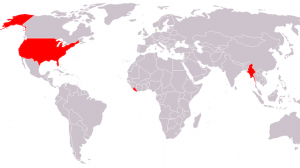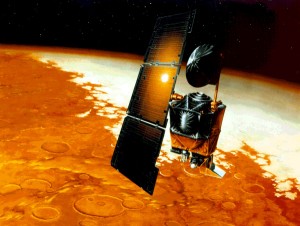Measurement is a vital mean used to convey information in society today. It is used countless times every day, whether you are aware of it or not. But what happens when there are multiple systems to choose from? Similar to language barriers we have ways to translate between the USCS and SI units, through conversions. Just like with translations, error can arise when switching between one another, leading some to question the need for a unifying standard. In the world today all but 3 countries, including the US, have yet to adopt the Metric system as their standard unit of measurement. In this essay I will shed knowledge on the debate of whether or not the United States should adopt the Metric system and abandon the Imperial system used so readily now.
Background

World map showing countries that use the imperial system highlighted in red. Image courtesy: Logix Insulated Concrete Forms Ltd.
Imperial measurement in the United States began during the American Revolution where it was taken directly from Great Britain the country for whom they receded from. Inches, gallons, and Fahrenheit are just a few of the all familiar measurements known by the average American today because the units have been used greatly ever since. It wasn’t until the French Revolution in 1789 that sparked a committee of scientists to approach the King of England requesting a unified system of weights and measurements. In 1824 the British “Weights and Measurements Act” set in motion what we consider the SI system today (Wrigley, 3). All around the world, the highly popular metric units have influenced and shaped countries, while becoming a benchmark and staple for measurements in years to come. Today all but three countries, Liberia, Myanmar and the United States of America, have yet to adopt this system.
Problems with USCS
Similar to the International System of Units the United States Customary System is able to create multiples of its base units. These conversions are a bit sporadic though with 12 inches to a foot, 5280 feet in a mile. The metric system offers everything in multiples of 10 and uses the prefix to designate the amount. For example 1000 grams is equal to 1 kilogram, and “kilo” means 1000 (Pete). Many agree that SI conversions are much simpler since they can be derived from their names themselves. That is why metric is widely used in science community around the world where math is needed to manipulate forms. Yet there is one big name in science that is still sticking to imperial units.
Ever since it began, NASA has dealt with imperial units of measurement while the other space programs used the more conventional metric system. This wasn’t a problem until 1999 where a mishap of measurements used to operate the spacecraft caused the destruction of the Mars Climate Orbiter (Reichhardt). This easily avoidable mistake could have been prevented by unifying to the already popular metric system, unfortunately this event costs NASA $125 million (Lloyd). Still today the company is hesitant to switch saying that the “$370 million cost to convert to Constellation programme to metric is too high” (NASA). This data leads many to wonder the enormity of the operation needed for a conversion to be done to the entire country rather than a single company seen here.
Another field where we can see the metric system rising is in that of medicine. As you might have thought measurement is a key component in treating patients. It is needed to prescribe the right dosage or collect the right information from instruments. Astonishingly around 70,000 children are admitted to hospitals each year because of related overdoes instances. Of these cases eighteen percent of which were caused by the parents who misunderstood the metric measurement (Goodyear). Confusion arises because once again, there is a combination of both systems; Imperial is sometimes used when talking about fluids in the sense of a teaspoon while on the other hand solids are usually measured out in grams. Other countries like Britain have been strictly using only metric units for distribution. Studies have shown that the amount of error there is significantly less than that in the United States (Goodyear).
Problems with SI

Outdoor thermometer reading temperature in degrees Celsius and Fahrenheit. Image courtesy: Pacific Crest Trail.
Clearly metric has the upper hand in science due to the simplicity of the conversions between units, but when it comes to everyday practice; Imperial units are often handier because of their unique size. Take the foot for instance; it is in the middle of the large gap between a centimeter and a meter, making it the unit of choice for carpenters and other building oriented careers. It is impractical to measure using a distance of 30 centimeters instead of one foot because it “violates all the advantages of the metric system”, from the inaccuracy felt from large values in small units (Spodek). Another thing that is more useful for everyday life is the USCS temperature Fahrenheit instead of the SI degrees Celsius. For every one degree change in Celsius, results in roughly a two degree change in Fahrenheit (Wrigley, 2). Meaning Fahrenheit is a lot less dramatic that Celsius and should be used when operating sensitive instruments such as the thermometer on a thermostat. By using USCS we are able to get a more control over what temperature it should be and thus not be constantly altering the Celsius degrees.
One place USCS is used greatly is in foods and baking for Americans. A gallon of milk, two cups of sugar, five tablespoons of vanilla… sounds all too like a recipe Grandma made for her homemade cookies, but change these instructions to metric and you will get something that sounds pretty foreign to the average baker, 3.7 liters of milk, 1.18 kilograms of sugar, 73.93 milliliters of vanilla. Early on Americans have been taught the Imperial measurement system through the guidelines set by the US government for elementary schools. This is because all US road signs and other necessary measurements use Imperial parameters, thus developing comprehension of the system is crucial (WiseGEEK).Visitors who come to the United States have to adapt to these unit constraits. Noice on the speed limit sign how mph is not marked, this might be common sense for American citizens but for foreigners might be an accident waiting to happen.
Solutions
As much of a black and white problem choosing between metric or imperial might seem the solution is not as clear as hoped for. An entirely metric world makes sense from a scientific perspective of being able to use the logic base of 10 to everyone’s advantage. For most Americans the switch to an entirely different system would come as a challenge in and of itself. Heney describes the situation as having to constantly be converting units in your head to know exactly the right value from the past experience living with USCS. He states if you, “grew up thinking in Metric there wouldn’t be any problem” (Heney).
The push for convergence to the SI system is not felt strongly by the US government, but rather by engineers and scientists who are using it every day to advance humanity. Unfortunately the people who are ready for the switch are not the types to be able to grab the politician’s interest. Global interoperability would create many economic benefits when dealing with other countries. Sadly the difficulty of switching our national measurement system lies in the economic costs. It is estimated that it would cost trillions of dollars to make the switch and spending these amounts of money drown interest of ever gaining ground for resolution of the issue. As much as people want to switch, one thing is certain, that no one wants to be the generation who has to “juggle” between two systems (Heney). Favor and interest is needed to get a hold of the politician’s attention and ignite such drastic change.
We are miles away from switching to metric. There are many benefits of the SI system, but by also abolishing the USCS we will also lose some of the familiarity for the time being. As always, using two systems can result in error when dealing with an extra variable like conversion. That is why within the next few decades to come the switch might become inevitable or may be perused with open arms from the evermore growing interest of Americans.



You’ve got a few misspelled words, but other than that good job! You messed up in the first paragraph
With havin so much written content do you ever run into any
issues of plagorism or copyright violation? My blog has a lot of completely unique content I’ve
either created myself or outsourced but it seems a lot of it is popping it up
all over the web without my permission. Do you know any solutions to help protect against content from being ripped
off? I’d truly appreciate it.
Thanks! Do you do your blogging through WordPress? If so you can install this plugin to help combat paganism https://wordpress.org/plugins/wp-content-copy-protection/
bookmarked!!, I like your blog!
Wow, amazing weblog format! How long have you been blogging for?
you made blogging glance easy. The overall
look of your web site is excellent, as neatly as the content!
Hi, i think that i saw you visited my website so i came to “return the favor”.I
am attempting to find things to improve my web site!I
suppose its ok to use some of your ideas!!
My wife and i felt absolutely excited that Michael managed to finish off his investigations because of the precious recommendations he came across from your web pages. It is now and again perplexing just to happen to be giving freely instructions which usually people today may have been making money from. And we do understand we now have the website owner to thank because of that. The entire illustrations you have made, the straightforward blog navigation, the relationships your site help instill – it’s got all powerful, and it’s aiding our son and the family understand this subject matter is interesting, and that is extraordinarily pressing. Thank you for the whole thing!
whoah this weblog is magnificent i really like reading
your articles. Stay up the good work! You recognize, lots of individuals are hunting around for this
information, you can help them greatly.